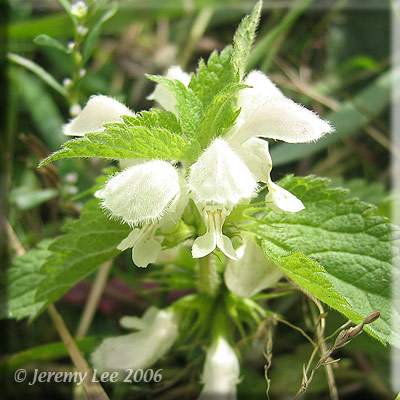
 |
|
Scientific Classifications explained » Amphibians » Ants » Aphids » Bees » Beetles » Birds » Bugs » Butterflies » Caterpillars » Damselflies » Dragonflies » Earwigs » Flies » Frog/Leafhoppers » Fungi » Galls » Grasshoppers » Harvestmen » Hoverflies » Lacewings » Ladybirds » Leaf Mines » Lichens » Mammals » Millipedes » Mosses » Moths » Sawflies » Slugs » Snails » Spiders » Trees » Wasps » Wild Flowers » Woodlice » PB |
UK Nature > Wild Flowers > White Wild Flowers > Lamium album

Scientific Name: Lamium album Common Name: White Dead Nettle Lamium album, commonly known as the White Dead Nettle, is a flowering plant in the family Lamiaceae, native throughout Europe, growing in a variety of habitats from open grassland to woodland, generally on moist, fertile soils. It is a herbaceous perennial plant growing to 50-100 cm tall, with green, four-angled stems. The leaves are 3-8 cm long and 2-5 cm broad, triangular with a rounded base, softly hairy, and with a serrated margin and a petiole up to 5 cm long; like many other members of the Lamiaceae, they appear superficially similar to those of the Stinging Nettle, Urtica dioica, but do not sting, hence the common name "dead nettle". The flowers are white, produced in whorls ('verticillasters') on the upper part of the stem, the individual flowers 1.5-2.5cm long. Very common throughout most of the UK, but scarcer in N. Scotland. |
|

https://www.uknature.co.uk is a website dedicated to showing the immense diversity of UK nature and wildlife. Our vast range of habitats, from lowland arable to snow covered mountains, from storm-ravaged coastlines to peaceful inland freshwater lakes and rivers, from dry, sandy heaths to deciduous and coniferous forests, all these habitats contribute to the abundance of UK nature. We have wild birds in huge numbers either residing or visiting our shores (597 recorded species as at July 2013) and we must also not forget the humble back garden with its grass lawns, flower beds filled with nectar rich flowers, shrubs and trees, all designed to attract huge numbers of insects such as bees, moths, butterflies and hoverflies; and finally the small ponds which provide safe havens for frogs, toads, newts and even slow worms and grass snakes. www.uknature.co.uk is the showcase for my personal passion, photographing uknature in all its glory. I sincerely hope you all enjoy the fruits of my labours. This site and all images contained therein is © Jeremy Lee 2004 - 2025. All Rights Reserved. Site design by Jeremy Lee. Site development & IT Support by Stuart Lee. |